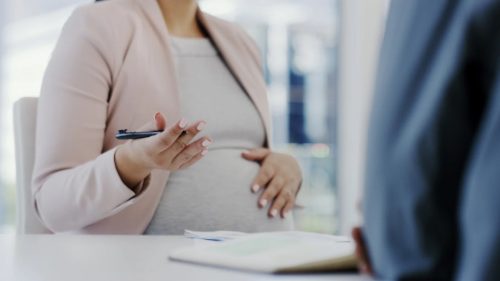In the UK, navigating redundancy during maternity leave requires a careful balance between business needs and employee rights. While redundancy is not unlawful during maternity leave, it must be handled according to strict legal requirements.
Failing to do so can result in claims of unfair dismissal or discrimination. This guide explores the laws, obligations and protections that apply to employees on maternity leave facing redundancy.
What Does the Law Say About Redundancy During Maternity Leave in the UK?

The legal foundation for redundancy protection during maternity leave is established under the Employment Rights Act 1996, alongside amendments introduced in 2024.
Under these regulations, employers are not prohibited from making someone on maternity leave redundant, but they must follow a lawful and non-discriminatory process.
To comply with the law, employers must ensure that:
- Redundancy is genuine (e.g., business closure, a diminished need for certain roles, or organisational restructuring)
- The selection process is fair, objective, and unrelated to the employee’s pregnancy or maternity leave
- Employees on maternity leave are offered any suitable alternative employment as a priority
The law applies only to those who have employee status, meaning they have a contractual relationship with the employer and are not working in a freelance, casual, or agency capacity.
Workers without this status, such as those on zero-hours contracts, do not receive the same redundancy protections under this legislation.
Employers must also conduct redundancy consultations with affected employees, regardless of their leave status, ensuring they are kept informed and involved in the process.
What Is the Redundancy Protected Period and Who Qualifies for It?
The redundancy protected period is the timeframe during which an employee who is pregnant or has recently taken a qualifying form of parental leave is protected by law.
This period provides specific rights in redundancy scenarios, particularly the right to be offered a suitable alternative vacancy ahead of others.
The start and end of the protected period are determined by two key factors:
- The type of parental leave being taken
- The date the employee notifies the employer of their pregnancy or parental leave
An employee qualifies for this protection if they are:
- Pregnant and have informed their employer
- Taking or returning from maternity, adoption, shared parental, or neonatal leave (from April 2025)
The table below provides a breakdown of how long the protection lasts based on the type of leave.
| Leave Type | Protection Start | Protection End |
| Maternity Leave | When pregnancy is disclosed | 18 months from the baby’s date of birth |
| Adoption Leave | Start of adoption leave | 18 months from adoption or child entering the UK |
| Shared Parental Leave | Start of leave | Varies: ends after leave or up to 18 months (6+ weeks leave) |
| Neonatal Leave (from 2025) | Start of neonatal leave | 18 months from birth/adoption |
The redundancy protected period ensures that even after returning to work, new parents are still covered by extended protections, giving them time to transition back into their roles without fear of unfair dismissal.
How Long Does Redundancy Protection Last for Pregnant Employees?

From 6 April 2024, the redundancy protected period was extended significantly. Previously, employees were protected only during their time on maternity leave. The change ensures that protection now extends for a total of 18 months from the date of the child’s birth.
This protection begins as soon as the employee informs their employer that they are pregnant, regardless of how far along they are in their pregnancy or whether maternity leave has commenced.
If an employee does not disclose the exact date of the baby’s birth, the protected period is calculated as 18 months from the expected week of childbirth.
Special Circumstances
There are additional provisions for employees who experience pregnancy loss:
- If a stillbirth occurs after 24 weeks, the employee is entitled to the full 18-month redundancy protected period from the date of the stillbirth.
- If a miscarriage occurs before 24 weeks, the protected period lasts only for two weeks from the end of the pregnancy.
These protections ensure that employers continue to treat affected employees with dignity and provide them with the same legal consideration as others returning from maternity leave.
What Are the Rules for Redundancy on Adoption, Shared Parental and Neonatal Leave?
In the UK, redundancy rules for employees taking adoption leave, shared parental leave, and soon, neonatal leave, have been strengthened to offer enhanced protection.
These changes ensure that new parents are not placed at a disadvantage or treated unfairly in the event of organisational changes during or shortly after taking leave to care for a child.
Adoption Leave Redundancy Protection
From 6 April 2024, employees taking adoption leave are entitled to the same level of redundancy protection as those on maternity leave. This legal change reflects a growing recognition that adoptive parents should receive equal treatment in employment matters.
The redundancy protected period for adoption leave begins on the first day of the adoption leave and extends for 18 months from one of the following dates:
- The date the child is officially placed with the adoptive parent in the UK
- The date the child enters England, Scotland or Wales in the case of an overseas adoption
During this 18-month window, the employee must be given priority access to any suitable alternative vacancies if a redundancy situation arises. This means they should be offered a suitable role before other employees, regardless of comparative qualifications or experience.
Failing to make such an offer can amount to automatic unfair dismissal, and in some cases, could also be seen as unlawful discrimination.
Employers must also ensure that adoption leave is not used—directly or indirectly—as a factor in selecting someone for redundancy.
Any scoring systems or assessments used during the redundancy process must exclude references to leave-related absence.
Shared Parental Leave Redundancy Protection
Shared parental leave (SPL) offers flexibility for parents to share up to 50 weeks of leave and 37 weeks of statutory pay. However, this flexibility also makes redundancy protections more complex.
The redundancy protected period for shared parental leave depends on the duration and structure of the leave taken:
- If the employee takes less than six consecutive weeks of SPL, the redundancy protection only lasts until the end of that period of leave.
- If the employee takes six or more consecutive weeks of SPL, then redundancy protection is extended to 18 months from the date of the child’s birth or adoption.
- If the leave is taken in discontinuous blocks, the protection only applies during the actual time away from work, ending with each individual leave period.
Importantly, if an employee has previously taken maternity or adoption leave, and then transitions into shared parental leave, the longest applicable protected period applies. This ensures that parents are not penalised for choosing a flexible leave arrangement.
For example, if a mother takes 26 weeks of maternity leave and then switches to shared parental leave, her redundancy protection will still be based on the 18-month period from the child’s birth, provided the leave meets the six-week minimum threshold.
Employers must track the structure and duration of SPL carefully to ensure they apply the correct redundancy protections during each phase. The failure to do so could expose them to legal risk and claims of unfair treatment.
Neonatal Leave Redundancy Protection (Effective April 2025)
From 6 April 2025, new legislation will introduce neonatal care leave, giving employees the right to time off if their child requires specialist care following birth. This type of leave applies to:
- Biological parents
- Adoptive parents
- Intended parents in surrogacy arrangements
To qualify for redundancy protection under neonatal care leave, an employee must take at least six consecutive weeks of leave. Once this threshold is met, they are granted an 18-month redundancy protected period, beginning from:
- The date of the child’s birth for biological and intended parents
- The date of adoption placement for adoptive parents
- The date the child enters Great Britain, in the case of overseas adoption
Neonatal care leave was introduced in recognition of the emotional and practical strain placed on parents whose newborns require hospital care. The extension of redundancy protection ensures these employees are not further disadvantaged upon returning to work.
Employers must prepare now for this legal change by updating their HR policies and ensuring payroll and management systems are capable of tracking neonatal leave and the associated protected period.
Are Employers Allowed to Select Employees on Maternity Leave for Redundancy?

While it is not illegal to make someone on maternity leave redundant, strict conditions must be met. Employers must:
- Prove that the redundancy is legitimate and not connected to the employee’s pregnancy or leave
- Demonstrate that a fair selection process was followed
- Show that employees on maternity leave were offered any suitable alternative roles first, before offering them to others
Failure to follow these steps could lead to a claim for automatic unfair dismissal, and potentially pregnancy or maternity discrimination under the Equality Act 2010.
Employers cannot use maternity leave as a factor in redundancy scoring or performance assessment. All decisions must be based on business-related criteria, not the employee’s absence.
How Should Employers Handle Suitable Alternative Employment Offers?
When redundancies are unavoidable, the law mandates that employees in a protected period must be offered any suitable alternative employment roles available.
These employees must be prioritised above others, even if those other employees are also suitable for the role. Employers cannot ask protected employees to compete for roles on equal terms with others — they must receive the first offer if the job fits.
Factors for determining suitability include:
- The employee’s skills, experience, and previous job duties
- Whether the role is on comparable terms (pay, location, hours)
- Any need for reasonable adjustments upon return from leave
Employers must document their decision-making process and provide a clear explanation of:
- Why the employee was selected for redundancy
- Why a specific role was considered (or not considered) suitable
This should be communicated in writing, ideally through a formal letter or email, and followed by a consultation meeting where the employee can ask questions and respond.
What Happens If There Are No Suitable Vacancies Available?

If there are genuinely no alternative roles available, and the redundancy process has been conducted fairly and transparently, the redundancy may proceed legally.
However, employers must be prepared to:
- Provide evidence that a comprehensive search for suitable roles was conducted
- Justify why no roles were considered suitable for the protected employee
- Show that all steps were taken to offer support and minimise the impact
Employers should also ensure that they:
- Do not make assumptions about the employee’s interest in returning to work
- Avoid discriminatory remarks or actions, even unintentionally
- Offer the same redundancy consultation rights and information as any other employee
In some cases, where multiple protected employees exist but only a limited number of suitable roles are available, employers may need to use objective criteria to determine who is offered the role.
However, the priority requirement still applies — these employees are not to be treated like others in a competitive selection process.
Conclusion
Redundancy during maternity leave is a complex area that requires sensitivity, transparency, and legal awareness. While it is legally permissible under certain conditions, strict rules exist to protect vulnerable employees.
Employers must prioritise suitable alternative employment and avoid discriminatory practices. Employees, in turn, should be informed of their rights and seek support when needed.
Staying informed, following the law, and treating each case with care helps both employers and employees navigate this challenging situation fairly.
FAQs
Can an employee be made redundant while pregnant but before starting maternity leave?
Yes, but only if the redundancy is genuine and unrelated to the pregnancy. The employer must follow a fair process.
What if the redundancy process started before pregnancy was announced?
If the employer was unaware, the redundancy may still be lawful. Once notified, the employee becomes protected under redundancy laws.
Is redundancy during maternity leave automatically unfair dismissal?
Not automatically, but failure to offer suitable alternative roles or using pregnancy as a factor can make it unlawful.
Can alternative employment be at a lower salary or different location?
It depends. If the alternative is suitable and reasonable, it can be offered. The employee can choose to accept or reject it.
How does shared parental leave affect redundancy protection?
Shared parental leave also triggers a redundancy protected period. The length depends on how much leave is taken.
What are an employee’s options if no suitable roles are offered?
They can challenge the redundancy, file a grievance, or take legal action through an employment tribunal.
Are employers required to notify in writing when making someone on maternity leave redundant?
Yes, all decisions must be documented and communicated in writing. This includes reasons and the redundancy process.





































